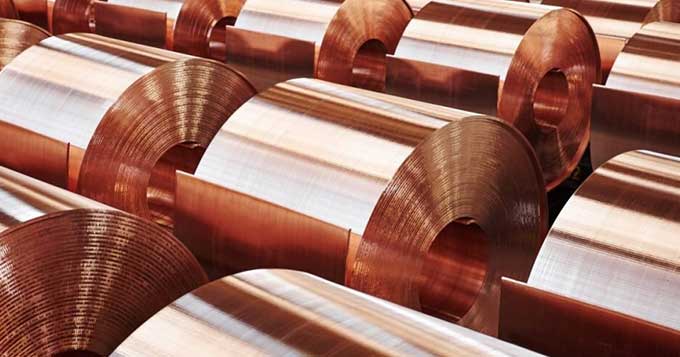Cooling With Responsibility
Mumbai: According to the weatherman, the mercury in April this year has soared the record hottest temperatures ever to have registered in the past 122 years. Coupling with the rising mercury are the blistering heatwaves scathing across the plains of northern and western region.
This significant escalation of temperatures has seen a direct relative peak in the electricity demands across the nation as well. With the summer is in full swing and air conditioning units working hard to keep people cool, our planet continues to warms, while the demand for space cooling (air conditioning and refrigeration) sets to incline further. With increasing incomes and standards of living, more families are starting to increase investments in air conditioners.
While our planet is warming, using and producing air conditioning equipment exacerbates climate change. The organic compound Hydrofluorocarbon (HFC) is the primary refrigerant used in air conditioning and refrigeration units. The HFCs are a much more potent greenhouse gas than carbon dioxide and are leaked anywhere from manufacturing air conditioning equipment, to installation, to the disposal of old units. Additionally, air conditioning and fans which are the biggest emitters of HFCs refrigeration units run on electricity that relies primarily on fossil fuels to generate power. As the need for cooling rises, so too will the need for electricity.
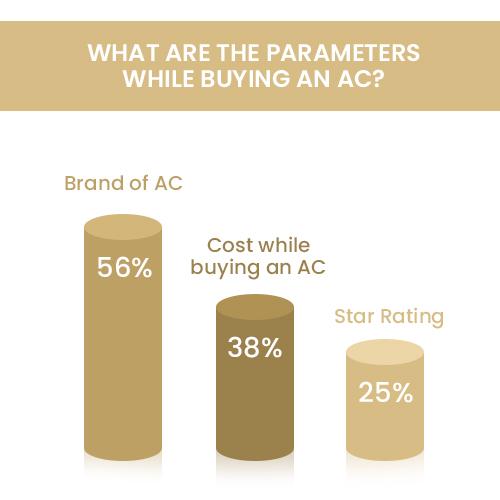
This indicates that we cannot stop using ACs and fans as temperature rises but we can definitely opt for appliances which are energy efficient, emits least amount of GHGs and use green refrigerants. Even though Star 5 Rated ACs can reduce energy demand by 50 percent, it ranks low in the purchasing criteria of consumer as per study by ICA India. Consumers rank purchase cost, brands, and cooling capacity as the top 3 purchasing criteria. Our survey outlined that for about 56 percent of Indian families the brand of the AC remained as the highest purchase driver than either star-rating or the quality standards offered by the device. According to the studies based on the inputs provided by retailers and distributors, the purchase cost stood as the second most critical point for 38 percent overall Indian households while buying an AC. The price of the AC seems to be the common denominator for majority of the states. The studies also found that only 25 percent of buyers purchased a four or five-star AC, which is the crucial aspect which not only helps save energy but also reduce electricity charges Meanwhile, the metallic-make (copper or aluminum) of the AC, which technically separates the high-efficient appliances from the low-efficient devices was a purchase driver for only 16 percent of the domestic consumers. The inputs provided by the Original Equipment Makers (OEM) also testify the survey outcome – as according to OEM that nation-wide a mammoth 82 percent of consumers consider purchase cost as the cardinal aspect while buying an AC. Following on the foot notes of this trend is the brand of the device which is on the lookout of 76 percent of buyers. Meanwhile, only 29 percent of households check the cooling capacity of an AC before making it part of their home.
The study further probed respondent on their association of Copper with ACs. An overall staggering 69 percent of consumers and 66 percent of service providers linked copper with reliability. The numbers continued to be strong in regards to durability as well with 65 percent and 66 percent, while ease of maintenance garnered support of 59 percent of buyers and 63 percent of service providers. A strong impression of it pivotal role in energy efficiency garnered seconding from 59 percent of consumers and 56 percent of service providers. In the department of branding, as per the service providers advocacy and promotions of copper and its benefits in AC saw 65 percent improvement in sales. The survey also underlined a growing trend of copper in the market with the support from 59 percent of the survey audience.
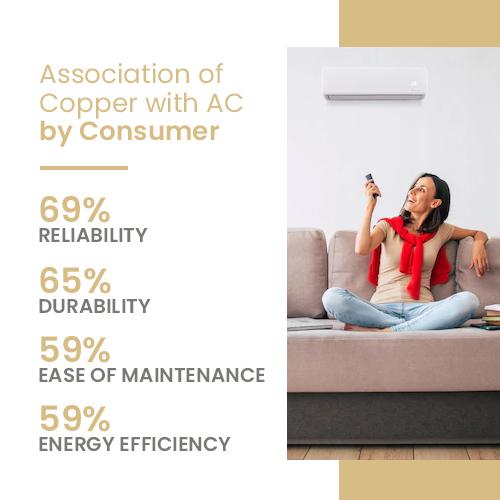
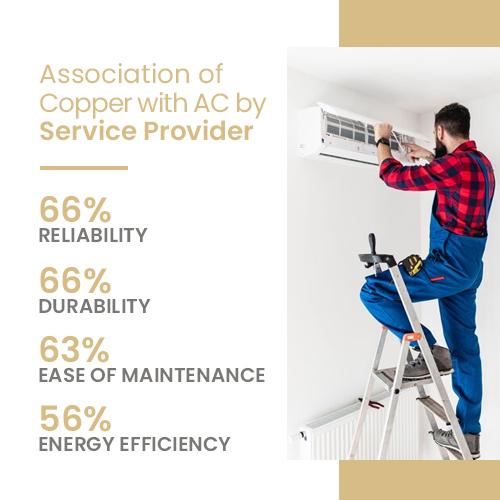
Copper has several advantage when it comes to air conditioners. Growing climate change concerns and an increase in minimum efficiency performance standards (MEPS) and labelling of room air conditioners worldwide have created a greater demand for product efficiency. Copper’s inherent properties are helping to meet this demand through improved designs. For example, smaller diameter, thinner copper tubes and the inner grooving of copper tubes have been used to optimize product designs and increase efficiency in heat exchangers. These modern MicroGroove® heat exchangers have dropped to 5 millimeters in diameter down from 9.52 mm over the past 20 years. They are more efficient, use less refrigerant and can work with high-pressure refrigerants.
In this way, Copper’s efficiency and its ability to be worked into smaller and more complex designs help to deliver better, more eco-friendly products for the same cost. Due to its anti-corrosion properties, refrigerant leakages in Copper ACs are much less as compared to Aluminum ACs. As per the study findings, Copper ACs are easy to clean and has very low failure rate (2 times in 10 years). On the other hand, Aluminium alloy ACs are difficult to clean due to its design leading to more failure (minimum 4 times in 10 years). It is easy to repair a copper heat exchanger of AC whereas, AL heat exchanger, when failed, has to be completed replaced. Based on interviews with Service providers, the study also highlighted that average cost of maintaining Copper ACs is Rs 1000 per years where is more than double for Al ACs at Rs 2200 per year. Further due to leakage, Aluminium ACs are two times more prone to impact the environment due to emissions of refrigerant into the atmosphere as compared to copper ACs. In this way, copper’s efficiency and its ability to be worked into smaller and more complex designs help to deliver better, more eco-friendly products for the same cost.
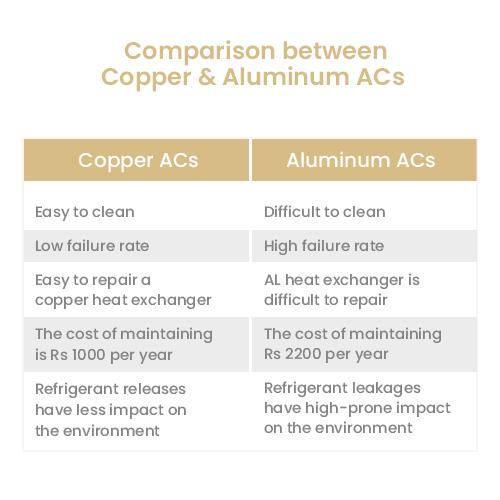
While consumers-particularly Millennials-increasingly voice that they want brands that embrace the purpose and the mode of sustainability, a frustrating paradox yet lingers at the heart of the green business. By recognizing, and realizing the importance of Copper in appliances in lower energy consumption and regulation of greenhouse gas emissions – is a much-needed responsible step towards a better, greener, and cooler tomorrow.


